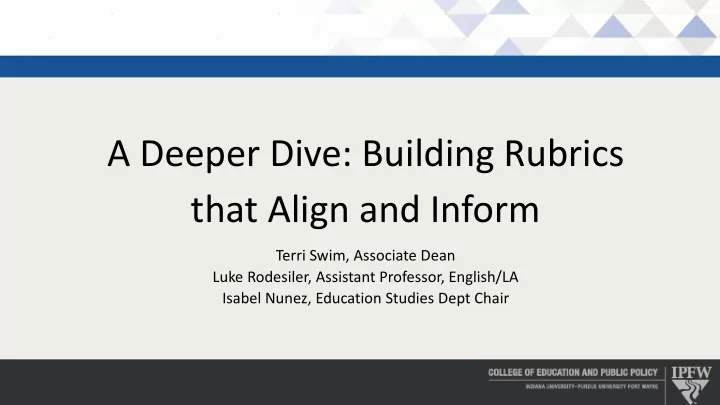

A Deeper Dive: Building Rubrics that Align and Inform Terri Swim, Associate Dean Luke Rodesiler, Assistant Professor, English/LA Isabel Nunez, Education Studies Dept Chair
Map of Indiana with IPFW located
Why assess? Have to (required by state or univ) Want to know if candidates possess knowledge, skills, and dispositions Want to improve program/unit Other …
Context – Differing Views on Assessment Accreditation or “accountability” processes represent a lack of respect and the placing of blame on teacher educators and teachers (Solbrekke & Sugrue, 2014). Reduction of the profession to quantifiable concepts that gives privilege to the types of knowledge that can be easily measured (Engebretsen, Heggen, & Eilertsen, 2012). Accreditation processes can be used to continuously improve our education programs (Mitchell, 2015).
How do we “do” accreditation work in this context?
Where do faculty learn rubric development? SPA and CAEP reviewers = training = deeper understanding that needs to be acquired for successful rubric development. From each other – critically examine own course-level assessments and rubrics From colleagues – discussions in monthly assessment or 1-on-1 meetings From SPA review feedback
The GAP …
Getting down to business … - Rubric Development - Example 1
Getting down to business … - Rubric Development - Example 2 - Handout 1 - CAEP Evaluation Framework for EPP-created Assessments
Getting down to business … - Rubric Development – English/LA - Example 3 - Handout 2
EDUC M447 Unit Plan – Fall 2014 Target Acceptable Unacceptable Instructional Practice Includes interesting variety of Includes a general variety of teaching Limited or no variety of methods. teaching methods. Includes rich methods. Uses methods that Limited or no use of methods that opportunities for students to accommodate various learning styles accommodate various learning 2003 NCTE Standard 4.7 draw on previous learning and and needs. Acceptable level of styles and needs. No reference to personal experiences and to connection to students’ prior students’ prior knowledge or life evaluate concepts critically. knowledge or life experiences. experiences. Considerable attention given to various learning styles and needs.
EDUC M447 Unit Plan – Fall 2015 Exceeds Expectations Meets Expectations Emergent Below Expectations Instructional Design: All, or almost all, plans for Instructional plans for Instructional plans for Instructional plans for composing texts are composing texts reflect composing texts suggest composing texts are Composition accessible to all students, understanding of writing an understanding of accessible to some but based on current English processes, are accessible writing processes and not all students and/or 2012 NCTE Standards language arts (ELA) to all students, and based appear, for the most part, plans include lapses in 4.1, 4.3 standards, reflect on current English to be accessible to all alignment with current understanding of writing language arts (ELA) students and based on English language arts processes, incorporate standards. The intent to current English language (ELA) standards. multiple learning styles, facilitate composing arts (ELA) standards. Yet, Instruction is not designed and explicitly identify experiences that utilize instruction presents little in ways that reflect an potential modifications individual and variation regarding genre, understanding of writing based on learning needs. collaborative approaches audience, purpose, or processes and little Instruction is designed to and to provide situation of writing consideration of or facilitate student- opportunities to write in events. variation in genre, centered, higher-order different genres for audience, purpose, or thinking tasks and to distinct audiences, situation of writing events provide opportunities to purposes, and situations is is evident. write independently and explicit and present in collaboratively in different some, although not all, genres for a wide range of lessons. audiences, purposes, and situations.
EDUC M447 Unit Plan – Fall 2016 Exceeds Expectations Meets Expectations Emergent Below Expectations Instructional Design - All or almost all plans for Plans for writing instruction Overall, plans for writing Instructional plans focused Writing: Accessibility writing instruction are reflect an understanding of instruction are accessible to on writing have limited accessible to all students, writing processes, are some but not all students accessibility to students at 2012 NCTE Standard 4.1 based on current English accessible to all students, and/or plans include lapses the target grade level. language arts (ELA) and are based on current in alignment with current standards, reflect English language arts (ELA) English language arts (ELA) understanding of writing standards. standards. processes, incorporate multiple learning styles, and explicitly identify potential modifications based on learning needs. Instructional Design - Instruction is designed to The intent to facilitate Though an understanding of Instruction is not designed in facilitate student-centered, composing experiences that writing processes is evident, ways that reflect an Writing: MAPS higher-order thinking tasks utilize individual and plans for writing instruction adequate understanding of and to provide opportunities collaborative approaches present little variation writing processes. Little 2012 NCTE Standards 4.3, for students to use language and to provide opportunities regarding the genre, consideration of or variation 4.4 conventions strategically as for students to use language audience, purpose, or in mode, audience, purpose, they write independently strategically as they write in situation of writing events. or situation of writing events and collaboratively in different modes for distinct is evident. different modes for a wide audiences, purposes, and range of audiences, situations is explicit and purposes, and situations. present in some, although not all, lessons.
Keys to Success - Help everyone learn strategies for creating strong rubrics - Include stakeholders - Think about these 4 concepts: … alignment of assessment to national standards, … alignment of rubric to the assessment, … alignment of rubric indicators to national standards, and … use of language to make qualitative distinctions in levels of performance
Recommend
More recommend